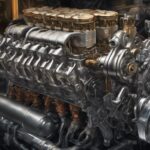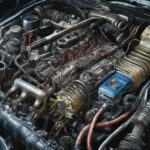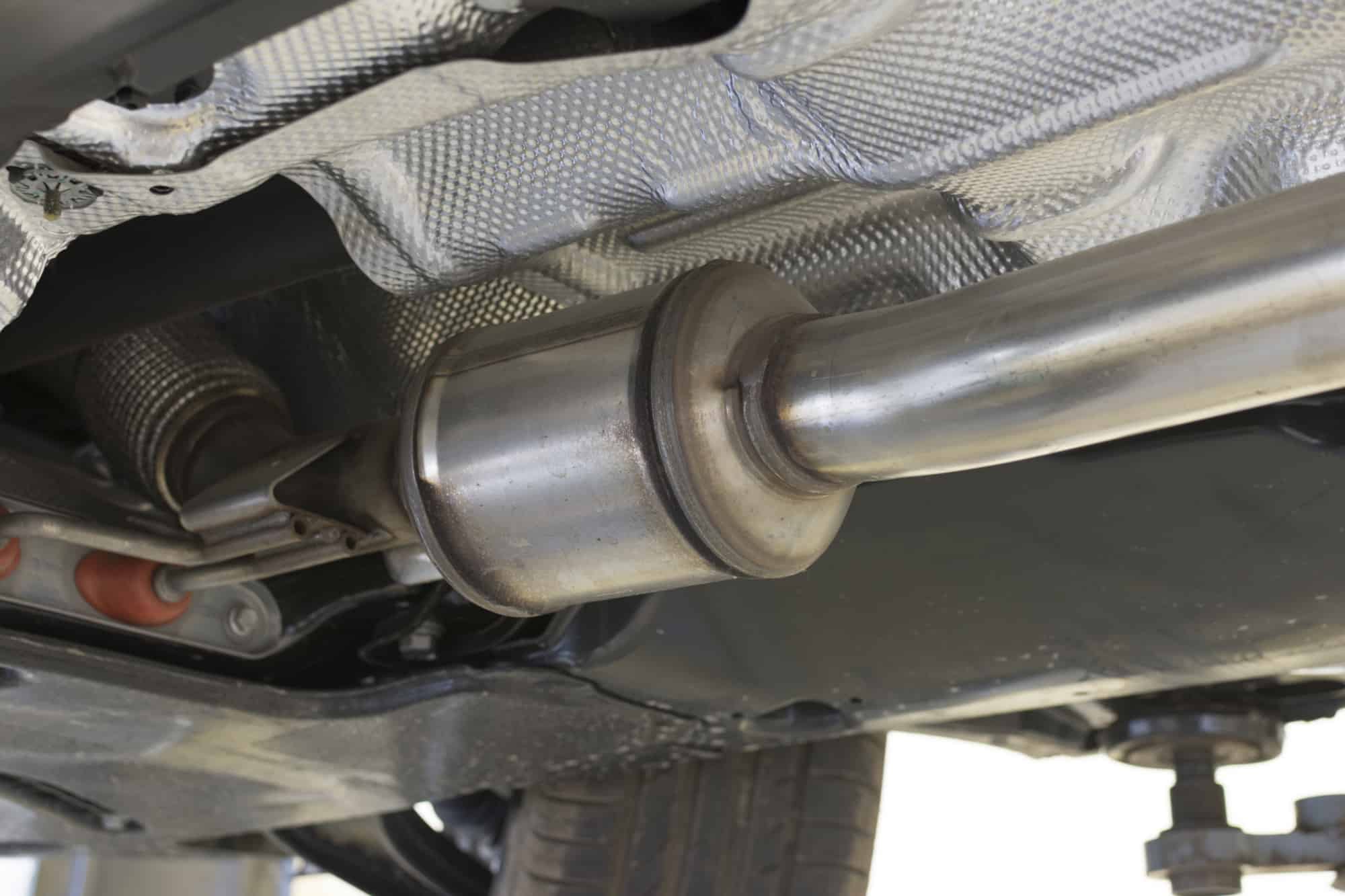A bad catalytic converter can wreak havoc with how well your engine runs. Catalytic converters can become blocked when the internal ceramic filter becomes clogged up so that it can no longer allow exhaust gases through. This affects its ability to filter the exhaust gas, but can a clogged catalytic converter cause a car to overheat?
Yes, a bad catalytic converter can cause an engine to overheat. This is because a bad or clogged catalytic converter will restrict the flow of hot exhaust fumes from the engine, which will heat up the exhaust manifold and cause the engine temperature to rise.
A bad catalytic converter will usually trigger the check engine light on the dash and there will normally be a reduction in engine power. If your car has these symptoms along with overheating, the catalytic converter may well be the cause.
Can a bad catalytic converter cause overheating?
A bad catalytic converter can cause overheating in cars, but it’s not the most common cause.
Usually, an engine that overheats has a problem with the coolant system. This can happen for many reasons such as a bad thermostat, a faulty water pump, or a leak that causes coolant loss. If the cat is to blame then how quickly the vehicle overheats depends on the condition of the coolant system and the current driving conditions.
A catalytic converter can cause overheating in the following way.
- A fully blocked, overheating catalytic converter will usually trigger the check engine light and this will be accompanied by a drop in engine power.
- The restriction of exhaust gases produced by the blockage will cause the exhaust manifold to heat up.
- The downstream oxygen sensor (the one fitted after the catalytic converter) will start to report out-of-range readings and this will affect the efficiency of the engine, depending on the vehicle possibly causing it to run richer than normal.
- If the coolant system is not cooling the engine as efficiently as it should, then the engine will overheat more quickly.
Modern engines may cut out shortly after start-up or not start at all if a blockage is detected, in order to protect the engine. If the engine continues to run indefinitely after it starts to overheat then the problem may be with the coolant system and not with the catalytic converter.
Bad Or Overheated catalytic converter symptoms
A blocked or continuously overheated catalytic converter have the same symptoms as they are both caused by the same problem.
These symptoms, can sometimes go unnoticed or be confused with other engine problems as the catalytic converter itself does not communicate with the ECU. Overheating of the converter or exhaust manifold can be difficult to spot unless they are accompanied by an overheated engine.
If the engine starts and is running then usually the first sign of any problems will be the check engine light or engine overheating light on the dashboard.
Symptom 1. Check engine Light on the Dashboard
Probably the most common symptom of an overheating catalytic converter is a check engine light. In most cases, a catalytic converter will not become completely blocked straight away and will continue to filter exhaust gases.
However, the speed and efficiency at which it can transport and clean the exhaust gases will reduce as it becomes more blocked. This drop in performance will be picked up by the oxygen sensors, often before it causes the engine to overheat.
The catalytic converter does not communicate with the ECU itself and therefore won’t trigger an engine error code.
However, the oxygen sensors fitted before and after each catalytic converter can detect any problems by comparing the level of oxygen in the exhaust fumes. Any change outside of the Ecu’s acceptable parameters will cause the check engine light to come on.
Common error codes related to a blocked catalytic converter include P0420, P0171, P0172, P0300-P0306. These codes indicate that the engine is running rich or lean, or that an individual cylinder is misfiring due to a problem with timing or some other related reason.
Symptom 2. A reduction in Engine Performance
Another common symptom of an overheating catalytic converter is a noticeable reduction in engine performance, especially under hard acceleration. The lack of power has two causes.
As outlined earlier, a blockage of the converter will prevent exhaust gases from leaving the engine as quickly as they should. This can lead to a reduction in the efficiency and power output of the engine.
A second reason for the loss of power is a problem with the engine and how it is running. This is actually one of the primary reasons why catalytic converters get clogged up in the first place.
If the engine is misfiring or is running rich or lean, or if there is unburnt fuel or even engine oil getting into the exhaust fumes, this will damage the catalytic converter.
Usually, the ECU will detect a problem with the engine and will try to compensate by tweaking the fuel flow rate or by adjusting the timing of the valves and the spark plug ignition.
Symptom 3. A burning smell and excess exhaust gas
A burning smell coming from underneath a vehicle when the engine is running can be a sign of a blocked or overheating catalytic converter.
The burning smell is caused by the overheating of the exhaust manifold, the catalytic converter and the exhaust pipe due to hot exhaust fumes being restricted as they leave the engine.
An overheating catalytic converter can also cause a rotten egg or sulphur smell to come from the exhaust. This is due to the higher levels of sulphur dioxide in the exhaust fumes that are not being adequately filtered out.
What Next – How To Check For a bad catalytic converter That Can cause a car to overheat?
If your vehicle is starting and runs without cutting out, then the catalytic converter is not completely blocked. There are a few simple checks you can carry out before you need to remove the catalytic converter for inspection.
If the check engine light stays on after the vehicle starts, then begin by running a diagnostic readout of the ECU to check for engine error codes. Specific codes related to the catalytic converter will be oxygen sensor out of range codes such as P0171, P0172, and P0173. These will tell you if the engine is running rich or lean, and may indicate a problem with the catalytic converter.
If there is no check engine light, but the engine is overheating after driving for a while, then this may point to an overheating catalytic converter, but it could also be, and is more than likely a problem with the coolant system.
Here are a few things to check to help diagnose the problem.
- Start by checking the coolant system. Check that the coolant system has enough coolant. Most modern cars have a coolant reservoir where you can check the coolant level. (older vehicles will have a radiator cap that can be removed to add fluid). If the fluid level is low then check for telltale signs of fluid leaks, these include dried chalky residue around the joints of coolant hoses and on the radiator connections. Check the rubber hoses for splits or tears, even small holes can leak a lot of fluid. Check the water pump for leaks at the gasket where it joins the engine block. There may also be fluid leak from the weep hole if the water pump is bad or failing.
- Check the backpressure of the exhaust system. The internal condition of the catalytic converter can be checked by measuring the exhust pressure before and after the converter. This is done by removing each oxygen sensor one at a time and fitting a back pressure gauge to each oxygen sensor socket. This will then give you a pressure reading on the engine side and exhaust side of the catalytic converter. Generally readings above 20PSI indicate a problem with the catalytic converter.
- Check the oxygen sensors. If the OBD reader has returned an error code related to the oxygen sensors then it’s a good idea to check each sensor for faults. Start by checking the oxygen sensor when fitted to the car. Oxygen sensors are always located before and after the catalytic converter and most modern cars have 2 to 4 sensors fitted, you’ll need to check your vehicles repair handbook for exact details on their location. Start by checking that each sensor is screwed tightly into place and is free from rust or damage. Check the wiring is not damaged and that the connector block is free from damage also. If everything looks ok, then you’ll need to remove each sensor one by one for further inspection and testing with a multimeter.
- Remove and inspect the catalytic converter. Removing the catalytic converter is the best way to inspect it. This is a specialised procedure and unless you have the correct tools it should be left to a workshop that specialises in this type of work.







Could this issue also negatively impact fuel efficiency?
Is it possible for me to check if my catalytic converter is the cause of my car overheating by myself, or do I need specialized tools to diagnose this accurately?